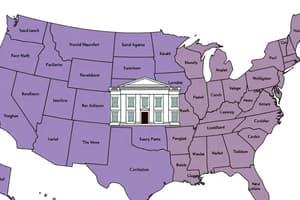Podcast
Questions and Answers
What is the main purpose of federalism in the United States?
What is the main purpose of federalism in the United States?
- To give unlimited power to the national government
- To establish a balance between national and state authority (correct)
- To prioritize state authority over national authority
- To eliminate state governments completely
In the U.S. Constitution, which powers are exclusively held by the national government?
In the U.S. Constitution, which powers are exclusively held by the national government?
- Regulating interstate commerce (correct)
- Local law enforcement
- State budget allocations
- Education policies
What does the Tenth Amendment of the U.S. Constitution primarily do?
What does the Tenth Amendment of the U.S. Constitution primarily do?
- Abolish all state governments
- Reserve powers to the states not granted to the federal government (correct)
- Grant unlimited power to the federal government
- Transfer all state powers to the national government
Which doctrine limits the federal government to only the powers specifically granted in the U.S. Constitution?
Which doctrine limits the federal government to only the powers specifically granted in the U.S. Constitution?
When did dual federalism become the primary framework of federalism in the United States?
When did dual federalism become the primary framework of federalism in the United States?
Which aspect of governance does dual federalism emphasize?
Which aspect of governance does dual federalism emphasize?
What is the main purpose of the federal system of government as described in the text?
What is the main purpose of the federal system of government as described in the text?
Which era of federalism in the United States emerged after the Civil War?
Which era of federalism in the United States emerged after the Civil War?
What has been a distinctive characteristic of federalism during the Rehnquist and Roberts courts?
What has been a distinctive characteristic of federalism during the Rehnquist and Roberts courts?
How has federalism in the United States adapted to changing demands over time?
How has federalism in the United States adapted to changing demands over time?
Which court invoked state sovereignty to preserve a zone of state autonomy?
Which court invoked state sovereignty to preserve a zone of state autonomy?
What does dual federalism aim to achieve in the United States?
What does dual federalism aim to achieve in the United States?
Flashcards are hidden until you start studying
Study Notes
Federalism: A Framework for United States Governance
Federalism, a foundational aspect of the United States Constitution, promotes a balance between national and state authority. This model of government, established in 1787, has evolved over time in the face of changing societal and economic needs while preserving the principles of limited government and state sovereignty.
Federal System of Government
The U.S. Constitution outlines the division of powers between the national government and the states. The national government possesses enumerated powers, including the ability to levy taxes, regulate interstate commerce, and engage in foreign relations. States retain authority over most matters not explicitly delegated to the federal government, such as local law enforcement and education.
Division of Powers
The Constitution grants the national government specific powers in Article I, Section 8, while the Tenth Amendment reserves to the states all powers not explicitly granted to the federal government or prohibited to the states. The enumerated powers doctrine, which limits the federal government to only those powers specifically granted, has been a cornerstone of federalism since the nation's inception.
Federalism in the United States: Dual Federalism
In the early 19th century, dual federalism emerged as the primary framework of federalism in the United States. This system sought to maintain a clear distinction between the powers of the national government and the states, with each entity having distinct spheres of authority.
Evolution of Federalism
Over its history, federalism in the United States has evolved through various eras, including post-Founding federalism, post-Civil War federalism, post-New Deal federalism, and most recently, federalism as interpreted by the Rehnquist and Roberts courts. Each period has seen shifts in the balance of power between the national government and the states as societal and economic demands have changed.
Dual Federalism Today
In the modern era, federalism in the United States has been characterized by the Supreme Court's rulings that protect states' rights and limit the federal government's powers. The Rehnquist Court, for example, invoked state sovereignty to preserve a zone of state autonomy. The Roberts Court has continued this trend by interpreting the New Deal federalism narrowly, allowing states more latitude in their governance.
Conclusion
Federalism in the United States has provided a dynamic framework for balancing the powers of the national government and the states. As societal and economic demands have changed, federalism has adapted to meet those needs, while preserving the principles of limited government and state sovereignty. By understanding the key tenets of federalism and the evolution of its implementation, we can better appreciate the complex and nuanced interactions between the various levels of government in our nation.
Studying That Suits You
Use AI to generate personalized quizzes and flashcards to suit your learning preferences.




